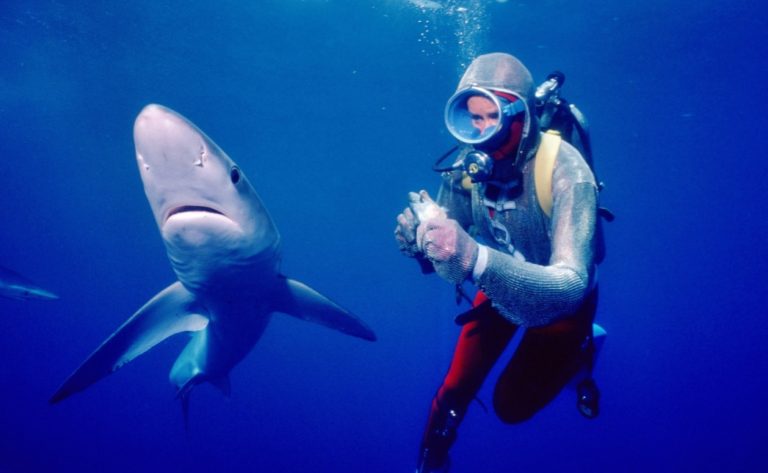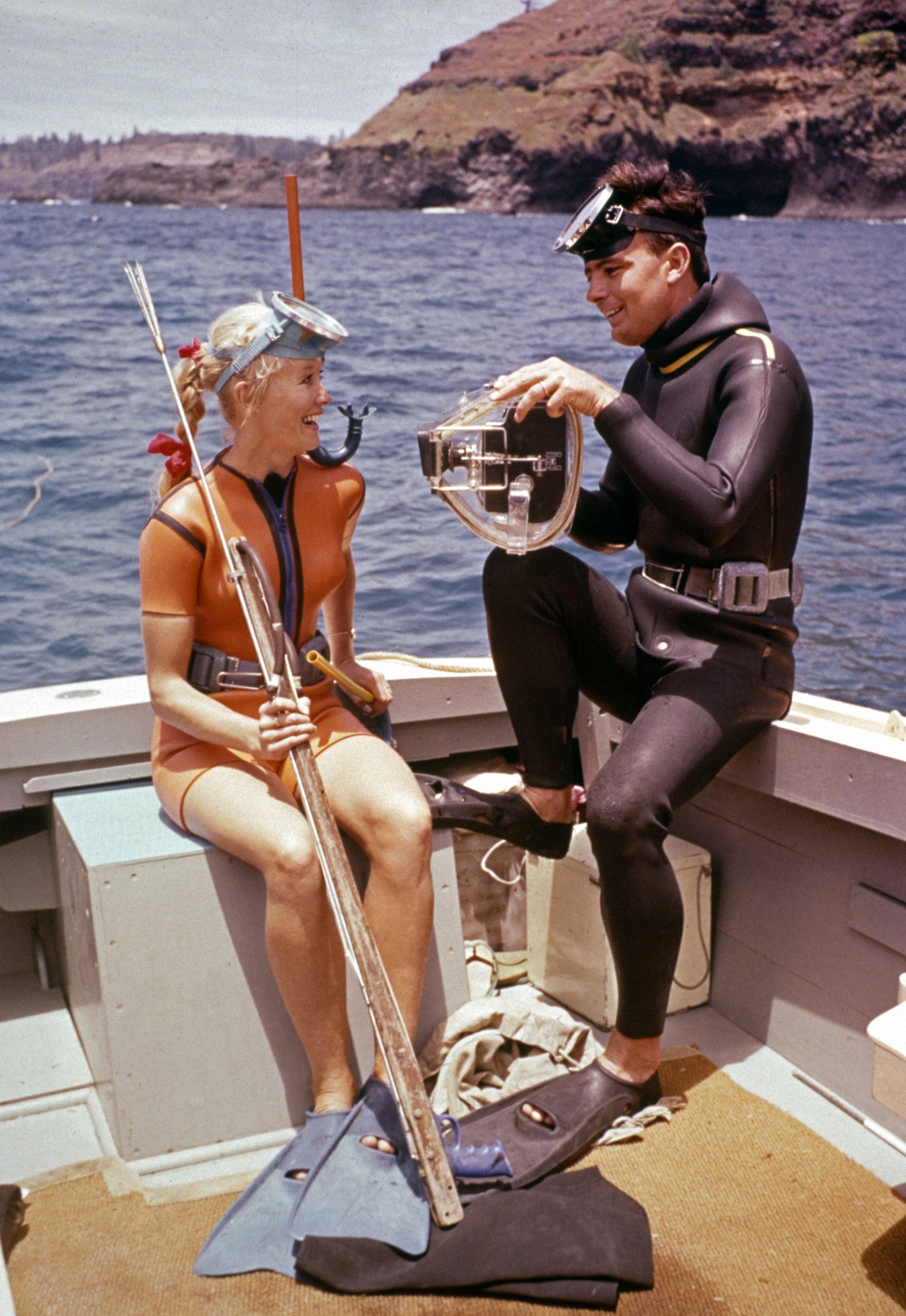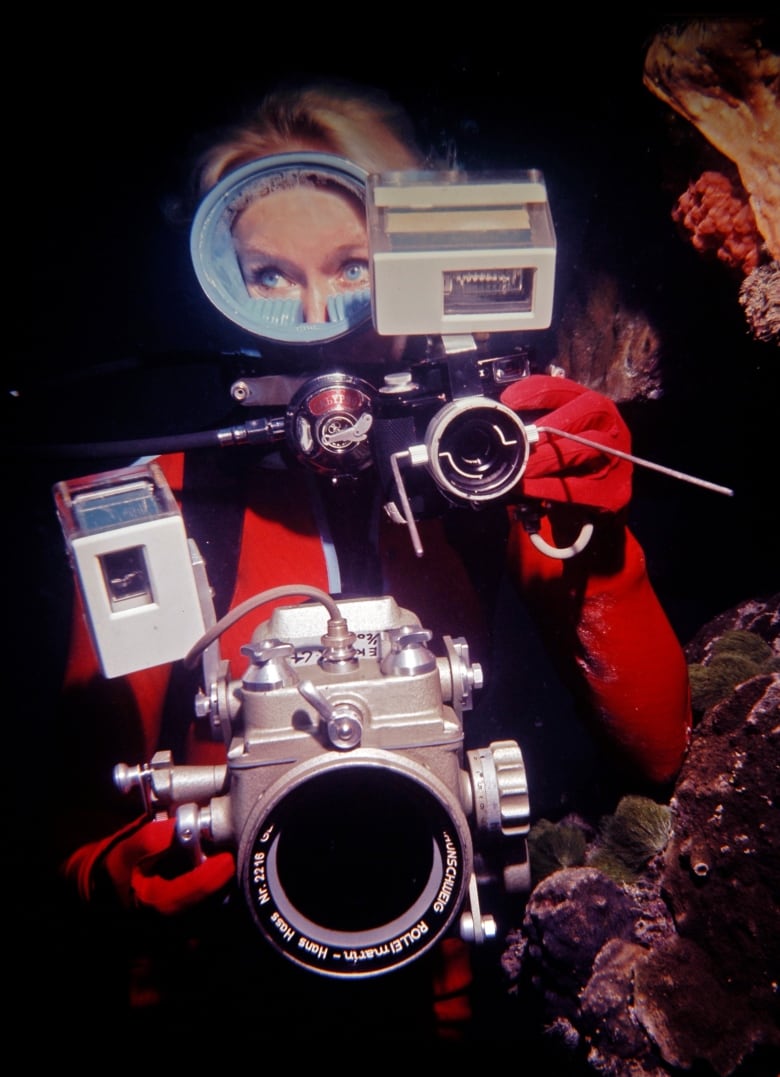
There are several visionary women who have inspired the world about the wonders of our planet, from Rachel Carson with her writings on environmental pollution and the natural history of the sea, to Jane Jacobs who championed a fresh, community-based approach to city building; from Alice Waters who advocated for local sustainable agriculture, to Jane Goodall who made ground breaking discoveries about the similarities between human and chimpanzee behaviour.
Then there is another exemplary woman, a pioneering and fearless human mermaid, who taught us how to befriend sharks. Sally Aiken’s documentary immortalises the story of a gentle warrior — with the looks and courageousness of Honey Ryder, played by Ursula Andress, in the James Bond film Dr. No — who has devoted her life to protecting the shark species: Valerie May Taylor.
The Nat Geo documentary Playing with Sharks: The Valerie Taylor Story, wreathes vintage video footage of Valerie’s underwater enterprises with her husband Ron Taylor, and interviews with the intelligentsia of the water world that include: Jean-Michel Cousteau (oceanographic explorer, son of Jacques Cousteau), Jeremiah Sullivan (Marine biologist), Wendy Benchley (president of Shark Savers-WildAid and widow of Peter Bencheley — author of the novel Jaws), Rodney Fox (spearfishing champion), Dr. Sylvia Earle (Marine Scientist), Stan Waterman (underwater filmmaking pioneer), Jayne Jenkins (underwater photographer), Howard Hall (underwater filmmaker), Carl Rosseur (dive tour pioneer), Douglas Seiffert (world editor, Dive Magazine).
Through the film presented at Sundance 2021 — available on Disney+ from July 23rd — we learn about the way the valiant champion of marine conservation had to overcome her own personal battles at an early stage in life, for instance when she contracted polio at only 12 years old. Not only did Valerie defeat the disease, but in the Fifties she became the only spearfishing woman in a male dominated culture, and that is what taught her the secrets of the water world.

Director Sally Aitken portrays the picture of a gentle Aussie lady, determined to defy conventions, who eventually found the perfect match for her enterprises. After meeting her husband, Ron Taylor — also a spearfishing champion and an underwater filmmaker — Valerie became his muse, as he filmed her swimming with sharks. Their shared passion for the marine fauna made them give up hunting, and they promised each other they would shoot sharks only with their cameras. It is utterly beguiling and eye-opening to observe the footage of Valerie swimming around these creatures in utter ease, as if they were her pets, feeding them and training them with great tranquility.
Valerie proved how mutual respect between humans and sharks can lead to a serene coexistence. In fact, she compares sharks to dogs, in terms of training and dangerousness. As a matter of fact, if one delves into the history of the way sharks were perceived, in the 16th century, the water predators were known to mariners as “sea dogs.” Valerie enhances how swimming in the ocean amongst them is not more perilous than other things. Risk is an innate part of life, embedded in each and every moment of every day, as she says: “Everything you do in life is a calculated risk, even a cup of tea could burn you.”
Although some people thought the Taylor couple played foolhardy, the adventures and expertise of Ron and Valerie attracted the interest of television networks and directors. The first American filmmaker to reach out to them was Peter Gimble for his feature Blue Water, White Death. What followed was the colossal Hollywood opportunity, when Steven Spielberg hired them to shoot Down Under, the shark scenes of the adaptation of Peter Benchley’s novel, Jaws.

Playing with Sharks: The Valerie Taylor Story shows the behind the scenes of this moment in film history, that will prove the message that Valerie tried to perpetrate ever since Jaws created a worldwide Galeophobia (fear of sharks): these creatures do not attack nor harm humans. To prove this point, the Taylors spent many years on talk shows trying to explain to audiences that there was a misperception about sharks, and they eventually filmed a scene to testify it, in which Valerie wearing a chain mail on top of her wet suit encouraged a shark to bite her arm. What happened was nothing like the blood and gore depicted with the man-eating great white shark in the Spielberg movie. On the contrary, with Valerie, the marine predator simply wrapped its mouth around her arm and left no marks, because sharks do not have crush power.
However in today’s culture sharks still have a bad reputation, as demonstrated by the most viewed youtube video in 2019: the children song Baby Shark — launched by South Korean education company Pinkfong — that further inculcates the fear of sharks. Even the English language works against these creatures, since the way to define a group of sharps is “a shiver of sharks,” alluding to the reaction they may trigger in swimmers, or in the best case scenario it may refer to the fact these animals are cold-blooded.
But Playing with Sharks: The Valerie Taylor Story truly changes the perspective. The most moving moment, that will soften all preconceptions, is when Ron and Valerie saved a shark, freeing it from some constrictions. The marine predator made no action to rebel or attack them, but allowed them to untangle the wires, almost as if it understood he was being helped. Unfortunately that same creature was captured by a fisherman five months later. To make things worse, during the Nineties the Chinese middle-class popularised shark soup, increasing the hunt for shark fins, allowing impoverished fishermen to earn good money with this trade.
Nevertheless, all of these vicissitudes did not discourage Valerie from advocating for the creation of national parks to protect sharks. Her lobbying for marine sanctuary zones in South Australia enabled the area of Dangerous Reef — where both Jaws and Blue Water, White Death were shot — to become part of the Sir Joseph Banks Group Conservation Park since 1989, that protects marine mammal habitat including the great white shark.
Even after her husband’s demise, Valerie still dives with her trademark outfit: a pink wet suit and red hair ribbon (the latter is an homage to Jacques Cousteau who always wore a red beret). Immersing herself in the water realm is something she encourages people to do, because as she puts into words: “Every dive has a potential to be a great adventure.”
Grade: A

